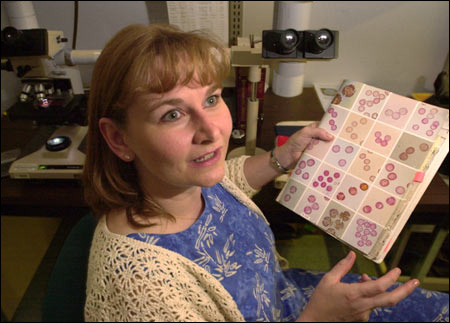Climate, asthma connected, according to research:
High pollen increases asthma suffering

Some variation on the headline “Asthma Rates on the Rise” has been appearing in newspapers all over the United States for so long and with such frequency that many readers’ brains just flatline when they see it yet again. But if you take the time to check the statistics, they are indeed startling.
According to Russell B. Leftwich of the American Academy of Allergy, Asthma, and Immunology, asthma incidence doubled, from 8.5 million to 17 million, between 1980 and 1998. That is, more people reported having more asthma attacks each year for two decades. And indicators suggest that rates continue to increase.
No one knows quite why, but scientists everywhere want to find out. Among them is Christine Rogers, a research associate at the Harvard School of Public Health (SPH). “Asthma is increasing everywhere,” she says, “not just in inner cities. There are definitely more children with asthma, and adult rates are increasing as well. And it’s a really complicated problem because it’s not entirely clear what mechanisms trigger the onset of disease.”
To figure that out, at least in part, Rogers measures particulates – pollen grains and fungal spores – in outdoor air and correlates levels with asthma events. She also examines how those particulate levels might change over time because of global warming. The results are not encouraging.
“One of the most predictable effects of global warming is that CO2 is going to increase,” she says. “But also, seasonality is going to change. Springs will come earlier, lengthening our growing seasons. Both of these trends affect plants’ biomass, making them larger at maturity and, logically, able to produce more pollen.”
Carbon dioxide, or CO2, stimulates net photosynthetic rates, so plants are able to more efficiently accumulate their food from the sun. It also improves plants’ water-use efficiency and decreases carbon loss, making plants – and their pollen-producing flowers – larger. “In terms of agricultural crops,” Rogers says, “to farmers it’s a great boon. Unfortunately, if you happen to be allergic to the kinds of pollen that are increasing, you may become sicker.”
To measure the effects of global warming on pollen production, Rogers and her colleagues forced ragweed plants to germinate two and four weeks earlier than they normally would, simulating the early springs that are likely to become more frequent. Half of each plant group was exposed to the normal, ambient CO2 level of 350 parts per million, and the other half to double that amount. Rogers found that total pollen production under ambient CO2 was higher in the plants grown in early spring than in those grown later. At high CO2 levels, however, plants grown later had higher total pollen production than those at ambient CO2.
“This could be a big problem for allergy sufferers,” she says. “Because it means earlier springs will increase the amount of pollen produced, but also that, given climate variability, with later springs under higher CO2, we’re still going to have higher pollen levels. So in years when we’d normally have lower pollen because of a later spring, higher CO2 rates mean we’re not going to have that relief.”
High CO2 levels increased total pollen production of ragweed in late spring seasons by a whopping 46 and 63 percent, respectively.
Another aspect of that study analyzed data on asthmatics in Paris and found that the number of doctor visits for asthma peaks during thunderstorms in the grass-pollen season. It is thought that during wet weather – another potential side effect of global warming – water is absorbed by the grass pollen grains, which then shoot out starch granules that carry allergenic proteins. The air becomes filled with these tiny particles, which are smaller than pollen and therefore more deeply inhaled, precipitating attacks in those who are sensitive.
A third part of the same study involves looking at large-scale atmospheric motion systems that cause climate variability over large geographic areas, using data gathered over more than a decade from 80 independent, voluntary aeroallergen monitoring stations throughout the United States. One finding is that El Niño, for example, can advance the pollen season by weeks for some types. “Not surprising,” Rogers says. “But if we can determine the mechanisms, the strength of the El Niño and how far things will advance, we can produce predictive models that can help people to avoid exposure.”
Along those same lines, Rogers is project manager for a five-year study – headed by Harriet Burge and Don Milton, also of SPH – funded by the National Institute of Environmental Health Sciences, this time examining not only pollen but also fungal spores in the atmosphere. “Of the estimated 1.5 million species of fungi worldwide,” says Rogers, “scientists have named and characterized maybe 70,000 or so. It’s a vast unknown out there, partly because fungi don’t grow well in laboratory cultures, and we can’t obtain good skin-test extract. So we don’t have a good handle on the types of fungi people are allergic to and the extent of fungal allergy.”
Researchers are collecting ambient outdoor air that contains all the allergens that people would be exposed to on a given day, and using it to make skin-test extract from the composite of each day. They’re then using the extract to skin-test people who had an asthma attack on that day and were treated at the Fallon Clinic in Worcester. They’re finding that people are sensitive to the skin-test extracts derived from outdoor air, suggesting that exposure to outdoor allergens may be important in exacerbating asthma. “It doesn’t allow us to look at unique, pure cultured entities,” Rogers concedes, “but it’s the best we can do.”
But with morbidity due to allergies and asthma exploding and no one able to explain why, every grain of knowledge counts.




